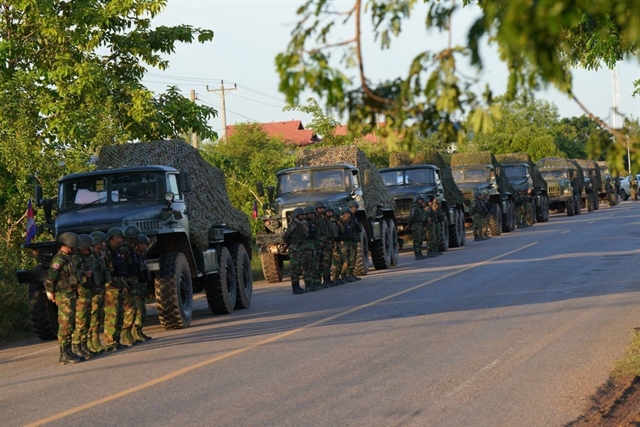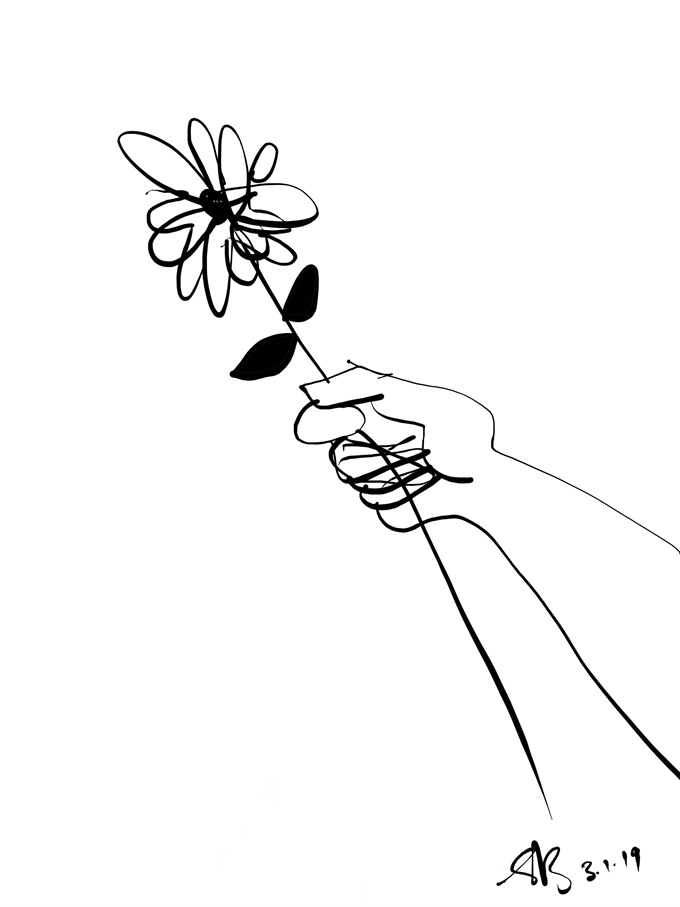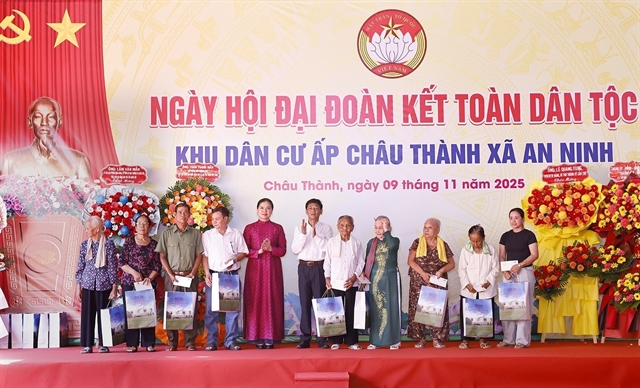 Features
Features

Hà Nội is not a city of imposing monuments, like other ancient cities. The history of Hà Nội is told on a rather modest, human scale: in pagodas, temples, communal houses, in the names of the streets.
 |
George Burchett*
When Xuân Diệu Street, on which I ride my motorbike every day, turns into a moving garden, I know spring has come and Tết is around the corner. Xe ôms (motorbike taxis) loaded with pots of kumquats, peach blossoms, pomelo trees of various sizes, from average to gigantic, move in both directions. Flower sellers push their baskets of beautifully arranged flowers on their bikes.
The area of Tây Hồ (West Lake) where I live has many orchards, which grow mostly kumquat trees for Tết. Hà Nội’s Flower Market is also nearby. Add to this the fruit sellers with their seasonal offerings, and throughout the year one is treated to a spectacle for all the senses. But around Tết, it becomes an exotic explosion.
The orchards on Đặng Thai Mai are crowded with customers choosing the perfect kumquat trees. They either carry those with them, or have them delivered. One has to admire those xe ôms, carrying several heavy pots with large trees and balancing their way through the busy two-way traffic on the rather narrow Xuân Diệu Street.
A few days before Tết, the local car washes get super busy, hosing and polishing cars and motorbikes to make them clean and shiny for the Lunar New Year.
On the eve of Tết, the hustle and bustle reaches its apogee: everybody is out shopping, completing last minute errands, sweeping, hosing, cleaning. It is what one could call the great pre-Tết spring cleanup and buying spree.
Then suddenly, Hà Nội comes to an almost total standstill. Most shops are closed, the streets are quiet and clean. The few cars and motorbikes are shiny and carry families dressed in their finest. Hà Nội suddenly becomes a model city: like in 20th-century posters foreign visitors to the capital like to take home as souvenirs. Even 24/7 construction sites shut down for a few days, while the workers return to their hometowns and villages to celebrate Tết with their families.
This is to me the true Tết magic. The cleanliness, peace and quiet of Hà Nội during the Tết celebrations. Most people are in their homes, celebrating the arrival of spring and the Lunar New Year.
Vietnamese friends often ask me: “Aren’t you bored during Tết? Everything is closed, everybody is spending time with family and relatives. Must be hard for a foreigner, with nothing much to do.”
But to me it’s a great time to be in Hà Nội. Many locals and expats leave town during Tết: locals to visit their hometowns or villages; expats to take a break from the usually rather chilly — and often rainy — early spring weather. But why would I want to be on a busy road, bus, train, airport, when I have almost all of Hà Nội to myself in all its Tết glory: a clean, quiet, safe and peaceful city, with minimal traffic.
This new lunar year, the Year of the Earth Pig, we will be sharing the peace of Tết in our neighbourhood with a new monumental presence. For the past few months we were witnessing the birth of a new goddess of some kind, a relative, I would think, of the numerous deities of Greek antiquity. She’s about five stories tall and of an imposing physique, strong arms and legs, ample bosom, her robust body wrapped in a tunic, whose folds fly in an imaginary wind. With her bare arms, she supports a palatial high-rise building named after the French Sun King – D’. Le Roi Soleil – on the corner of Xuân Diệu and Đặng Thai Mai. She smiles demurely at the world, from her great height and looks into the distance, facing East, towards the rising sun. I’ve observed her creation, from steel and concrete structure to her current and – I presume – finished state.
Although stylistically the new goddess relates to a distant classical western past, she also represents "new" Hà Nội, with its Royal Cities, El Dorados, neo-Versailles and other grandiose developments. If you Google D’. Le Roi Soleil, you’ll see images of a utopian future Hà Nội: green, clean, with wide streets that can accommodate large SUVs and assorted luxury cars – no plebian motorbikes, please! The original Roi Soleil, Louis XIV, would possibly have been impressed – although he may have winced at the gigantism of the sculpture and the faux marble and bronze around her.
And here is my dilemma. I – like most Hanoians – also wish for a cleaner and greener Hà Nội, the Hà Nội of the great Tết spring cleaning. But I also love the hustle-and-bustle of everyday Hà Nội, its constant street theatre, its humanity, its textures, its roosters crowing early in the morning, chickens, dogs, cats, birds – including the occasional majestic eagle being taken for a ride around West Lake by his proud owner.
After the brief peace and quiet of Tết, our neighbourhood again becomes busier than usual. It’s time to visit the pagodas on West Lake, especially Phủ Tây Hồ, dedicated to Thánh Mẫu, Mother of the Nation. It is an endless procession of motorbikes, cars and buses, bringing thousands of people to the temple. Stalls pop up around the special parking zone set up around the pagoda. People come to pray for good luck, to pay their respects to Thánh Mẫu and other deities and saints, bring them offerings of food and flowers, burn incense and lucky money. It’s part of long series of Tết celebrations around the country. That is how Vietnamese people reconnect with their families, ancestors, ancient heroes, saints, deities and gods. All Vietnamese, young and old, carry in them the culture, traditions, history, values of their country.
Hà Nội is not a city of imposing monuments, like other ancient cities. The history of Hà Nội is told on a rather modest, human scale: in pagodas, temples, communal houses, in the names of the streets. And it is a living history, not frozen in a distant past or locked within museum walls. In other words, in Hà Nội, history is always present, the past is part of the present, traditions and customs are alive in everyday life.
So where does the new gigantic white "goddess" fit?
In the spirit of Tết – the yearly time of renewal – I believe she should be welcomed and accepted into the great Hà Nội collective. And as she is supposed to herald a "cleaner and greener" Hà Nội of the future, perhaps she will inspire the developers of "new" Hà Nội to make their building sites "clean and green". After all, we – mere mortals – have to put up with the noise, dust, mud, increased traffic and many other inconveniences until their splendid palaces are completed and occupied by their new residents.
Hà Nội is a city of artists and many other creative professions. They can collectively contribute to transforming the hoarding of building sites into works of art, rather than surrender them to graffiti vandals. Wouldn’t that be truly wonderful – and in the best sprit of Hà Nội?
A group of dedicated young Hanoians, under the collective name of Hanoi Art Space, is showing the way, by decorating vandalised electric boxes around Hoàn Kiếm with bright flowers, with support from the Hà Nội People’s Committee.
May their initiative inspire others to make Hà Nội clean, green and beautiful in the Year of the Pig. And more and more so thereafter.
On this hopeful note, I wish everyone a happy, healthy and fulfilling New Year! VNS
*George Burchett is an Australian artist who was born in Hà Nội and lives in Hà Nội.




